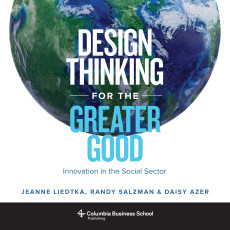
Design Thinking for the Greater Good: Innovation in the Social Sector
Jeanne Liedtka, Randy Salzman & Daisy Azer
352 pages, Columbia University Press, 2017
Design thinking is becoming increasingly popular. The practice—which authors Jeanne Liedtka, Randy Salzman, and Daisy Azer describe as “a problem-solving approach with a unique set of qualities: human centered, possibility driven, option focused, and iterative”—is no longer confined to the private sector. It is catching on with social entrepreneurs and practitioners, even within large, hierarchical, bureaucratic, and risk-averse social and public sector organizations. Like the authors of Design Thinking for the Greater Good at the University of Virginia, we at Stanford’s Stanford’s Hasso Plattner Institute of Design (also known as the d.school) are excited by this dramatic rise in interest in and practice of the approach.
Liedtka, Salzman, and Azer’s book makes an important contribution in outlining some of the challenges and opportunities of applying design thinking behaviors and mindsets in the social sector. They make a case for increasing the capacity needed to scale the approach across the sector, provide a framework for practitioners to apply it within their organizations, and offer case studies of organizations that have done so.
Part I encourages traditional, risk-averse organizations, which tend to focus on exploring existing solutions, to learn from the culture and behaviors of innovative, growth-minded organizations such as startups, which explore possibilities and insights and tend not to confine design-thinking mindsets and behaviors to a single team. The authors stress that startups should not be the only generators of social innovation. Instead, we need to focus on shifting the culture within large social sector organizations that have existing clout and capabilities to tackle social problems.
The book’s second part provides 10 stories of government-backed agencies in the United States, Canada, the United Kingdom, and Australia that are applying design thinking in areas such as agriculture, education, health care, transportation, social services, and security. And Part III provides tools to help practitioners prepare a design-thinking research plan for their own work.
I appreciate that the authors do not talk about design thinking as a cure-all and instead acknowledge the benefit of combining its experimental, expansive thinking with traditional organizations’ analytical approach. They hope to help people at both types of organizations better communicate with each other “by providing the tools and process to foster a better conversation across difference.” They want to encourage bureaucrats to increase their creative confidence and envision more possibilities; they also want to help innovators better navigate complex bureaucracies and employ skills and behaviors based on evidence-based analysis.
In my experience coaching hundreds of nonprofit teams and organizations, this balance is critical. Social innovation startups that are not incorporating big data, strategic planning, and systems thinking can waste time and energy pursuing ideas that might not address a critical leverage point in the system that can generate wide-spread support, and therefore, the intervention might be irrelevant. At the same time, practitioners within large bureaucracies can be paralyzed by analysis and may not make time to explore opportunities or possibilities that have not yet been tested.
I intend to share this book with my network, and especially with those looking for inspiring examples of how others have applied design thinking within their organizations. The book includes many examples for how design thinking can improve team dynamics, uncover opportunities, explore possibilities, and create greater alignment within and across organizations. While this is helpful for revolutionizing the management of social sector organizations, and identifying incremental project changes, it does not provide practical steps for social sector innovators trying to identify the most effective way to tackle multi-stakeholder, systems-level wicked problems.
The book does address the importance of systems-level problem solving, but it falls short in offering practical guidance of how design thinking can be used at the systems level. This is unfortunate, because to use design thinking effectively, organizations must understand not only how to create team alignment, but also how to combine design thinking with systems thinking and strategic planning. While the authors acknowledge this need, they could do more to offer specific guidance on how to do so.
When I coach teams on using design thinking to tackle social problems, their most frequent questions include: Where do I start? How and when do I integrate data and evidence? How do I manage multiple stakeholder needs simultaneously? How do we go from 10 ethnographic interviews to statistically significant sample sizes? How do we go from micro-level needs to macro trends? Once I uncover multiple needs, multiple insights, and multiple possibilities (which is inevitable within the social sector), how do I determine which ones are the most influential intervention in the system, especially if the opportunities are in different parts of the system?
If design thinking is to help address our greatest social challenges, we need to give teams the tools to determine the greatest leverage points when designing within complex systems and understand possible unintended consequences. We need to provide more details on how to sequence these steps: when to do a systems analysis, when to dig deeper with specific beneficiaries and stakeholders, and most importantly, how to choose between multiple possible solutions. Without understanding how to navigate this complexity, and connect insights to big data and evidence, teams can waste hours of time with interviews, synthesis, and experiments, undermining their sense of mission and the design-thinking method’s credibility within the organization.
Liedtka, Salzman, and Azer’s advice about advancing individual mindsets, organization culture change, and uncovering opportunities is necessary but not sufficient if design thinking is going to continue to be seen as a critical tool among social innovators—especially those working within large bureaucracies.

